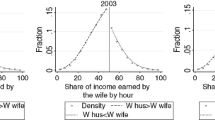Abstract
An increasing number and percentage of families in the United States endeavor to improve family income by placing two adults in the paid work force. This study examines the impact of the second earner on family income for 1,624 married-couple families with children, including 871 one-earner and 753 two-earner families. After-tax income is regressed on one- or two-earner status as well as covariates which confound the income-earner relationship for families of various income levels. The actual after-tax income differential of $7,172 is reduced to $6,076 in the regression analysis. Further, income for each family type is estimated by applying the regression coefficients from one-earner households to the characteristics of two-earner households and the regression coefficients from two-earner households to one-earner household characteristics. Actual incomes for two-earner families are found to be higher than those of one-earner families. However, income differences are reduced from 34% higher actual before-tax income to an estimated 14% lower after-tax income. The findings have important implications for families selecting two earners solely for the purpose of increasing after-tax income.
Similar content being viewed by others
References
Avioli, P. (1985). The labor-force participation of married mothers of infants.Journal of Marriage and the Family, 47, 739–745.
Becker, G. (1981).A treatise on the family. Cambridge, MA: Harvard University Press.
Bergmann, B. (1986).The economic emergence of women. New York: Basic.
Berk, R. (1983). An introduction to sample selection bias in sociological data.American Sociological Review, 48, 386–398.
Bronfenbrenner, U., & Crouter, A. (1982). Work and family through time and space. In S. Kamerman & C. Hayes (Eds.),Families that work: Children in a changing world (pp. 39–83). Washington, DC: National Academy Press.
Ferber, M., & Birnbaum, B. (1982). The impact of mother's work on the family as an economic system. In S. Kamerman & C. Hayes (Eds.),Families that work: Children in a changing world (pp. 84–143). Washington, DC: National Academy Press.
Fuchs, V. (1986). Sex differences in economic well-being.Science, 232, 459–464.
Greene, W. (1981). Sample selection bias as a specification error: Comment.Econometrica, 49, 795–798.
Heckman, J. (1979). Sample selection bias as a specification error.Econometrica, 47, 153–161.
Hogan, M. J., & Bauer, J. (1988). Problems in family financial management. In C. Chilman, F. Cox, & E. Nunnally (Eds.),Employment and economic problems (Families in trouble series, Vol. 1) (pp. 137–153). Newbury Park, CA: Sage.
Kamerman, S., & Hayes, C. (1982). Dimensions of change: Trends and issues. In S. Kamerman & C. Hayes (Eds.),Families that work: Children in a changing world (pp. 12–36). Washington, DC: National Academy Press.
Kinsey, J. (1984). Probit and tobit analysis in consumer research. In K. P. Goebel (Ed.),Proceedings of the 30th Annual Conference of the American Council on Consumer Interests (pp. 155–161). Columbia, MO: American Council on Consumer Interests.
Lazear, E., & Michael, R. (1980). Real income equivalence among one-earner and two-earner families.American Economic Review, 70(2), 203–208.
Oppenheimer, V. (1982).Work and the family: A study in social demography. New York: Academic Press.
Polachek, S. (1975). Potential biases in measuring male-female discrimination.Journal of Human Resources, 10, 205–229.
Pritchard, M., & Williams, F. (1987). Determinants of resource constraints experienced by one- and two-parent low-income households. In V. Hampton (Ed.),Proceedings of the 33rd Annual Conference of the American Council on Consumer Interests (pp. 214–220). Columbia, MO: American Council on Consumer Interests.
Strober, M. (1977). Wives' labor force behavior and family consumption patterns.American Economic Review, 67(1), 410–417.
U.S. Bureau of the Census. (1985).Household and family characteristics: March 1984 (Current Population Reports, Series P-20, No. 398). Washington, DC: U.S. Government Printing Office.
U. S. Bureau of the Census. (1986).Money income and poverty status of families and persons in the United States: 1985 (Advanced data from the March 1986 Current Population Survey) (Current Population Reports, Series P-60, No. 154). Washington, DC: U. S. Government Printing Office.
U. S. Bureau of the Census. (1988).Money income and poverty status in the United States: 1987 (Advanced data from the March 1988 Current Population Survey) (Current Population Reports, Series P-60, No. 161). Washington, DC: U. S. Government Printing Office.
U. S. Bureau of the Census. (1989).Money income of households, families, and persons in the United States: 1987 (Current Population Reports, Series P-60, No. 162). Washington, DC: U. S. Government Printing Office.
U. S. Department of Labor, Bureau of Labor Statistics. (1986a)BLS measures of compensation (Bulletin 2239). Washington, DC: U. S. Government Printing Office.
U. S. Department of Labor, Bureau of Labor Statistics. (1986b).Consumer expenditure survey: Interview survey, 1982–83 (Bulletin 2246). Washington, DC: U. S. Government Printing Office.
Weisbrod, B., & Hansen, W. L. (1968). An income-net worth approach to measuring economic welfare.American Economic Review, 58, 1315–1329.
Zick, C. (1985). Sample selection bias: Correcting for variables that aren't there. In K. P. Schnittgrund (Ed.),Proceedings of the 31st Annual Conference of the American Council on Consumer Interests (pp. 65–71). Columbia, MO: American Council on Consumer Interests.
Author information
Authors and Affiliations
Additional information
This study received funding from the Graduate School Fund at Northern Illinois University. An earlier version of this paper was presented at the Family Economics/Home Management Conference, Indianapolis, IN, June 1987.
Mary Pritchard is an Assistant Professor, Department of Human and Family Resources, Northern Illinois University, DeKalb, IL 60115. She received her Ph.D. from Purdue University and includes family economic well-being, family income and expenditures, and spending patterns of adolescents among her research interests.
Rights and permissions
About this article
Cite this article
Pritchard, M.E. The value of the second income to two-earner families with children. J Fam Econ Iss 11, 127–141 (1990). https://doi.org/10.1007/BF00987077
Issue Date:
DOI: https://doi.org/10.1007/BF00987077




